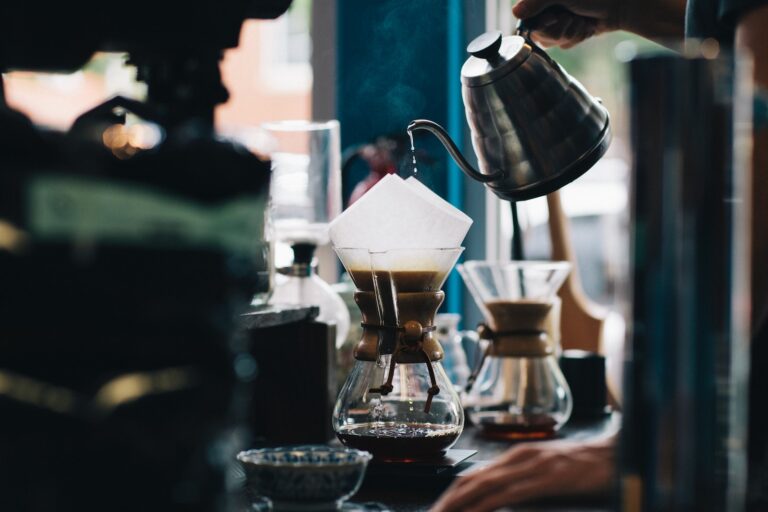Calling all coffee lovers! Have you ever wondered how that piping hot cup of blissful goodness ends up in your hands every morning? Well, get ready to embark on a tantalizing journey through the fascinating world of coffee production and processing. From the humble bean to the heavenly brew, join us as we delve into the secrets behind this beloved beverage.
Get ready for an aromatic adventure filled with intriguing facts, historical tidbits, and incredible stories that will leave you craving more. So grab your favorite mug, sit back, and let’s explore together: From Bean to Brew – The captivating artistry behind coffee production.
Introduction to the World of Coffee: History and Origins

Coffee is one of the most beloved beverages in the world, enjoyed by millions of people from all walks of life. But have you ever stopped to think about how this magical drink came to be? In this section, we will dive into the fascinating history and origins of coffee.
The story of coffee begins in Ethiopia, where it is believed that coffee beans were first discovered over a thousand years ago. According to legend, a goat herder named Kaldi noticed that his goats became more energetic after eating berries from a certain tree.
Curious, he tried them himself and experienced a similar boost in energy. Word spread about these mysterious beans and soon they were being used by monks for their stimulating effects during long hours of prayer.
The Coffee Plant: Types, Varieties, and Growing Conditions
Coffee is one of the most popular beverages in the world, with the global coffee production estimated to be around 167.4 million bags in 2021 (source). However, before it reaches our cups, coffee undergoes a long journey starting from the humble coffee plant. In this section, we will explore all the different types and varieties of coffee plants as well as their growing conditions.
Types of Coffee Plants:
Generally speaking, there are two main types of coffee plants – Arabica and Robusta. Arabica accounts for around 60 percent of global coffee production and is often considered to be superior in terms of taste and quality compared to Robusta. It has a more delicate flavor profile with notes of fruit and sweetness. On the other hand, Robusta is used primarily for its caffeine content and has a stronger and harsher taste compared to Arabica.
Varieties of Coffee Plants:
Within these two types exist numerous sub-varieties that have distinct flavor profiles owing to their unique genetic makeup. Some popular varieties include Bourbon, Typica, Geisha/Gesha (Arabica) and Catimor, Conilon (Robusta). Each variety grows best under specific climatic conditions which ultimately affects its flavor characteristics.
Growing Conditions:
Coffee plants thrive in tropical or subtropical regions where there is a good balance between heat, humidity, altitude, rainfall patterns, soil quality and acidity levels. Typically grown between latitudes 25 degrees north and 30 degrees south of the equator, coffee plants require a temperature range of 15-24°C (59-75°F) for optimal growth. This is why countries like Brazil, Vietnam, Ethiopia and Colombia are among the top producers of coffee worldwide.
The ideal elevation for coffee cultivation is between 4,000 to 6,000 feet above sea level. At higher altitudes, the cooler temperatures and thin air lead to slower ripening of the coffee cherries which results in a more flavorful cup of coffee. On the other hand, lower elevations tend to produce larger yields but with lower quality beans.
In terms of precipitation, coffee plants require an average rainfall between 1500mm to 2000mm annually for proper growth. However, they also need a dry period for flowering and ripening of cherries. This makes regions with distinct wet and dry seasons ideal for coffee cultivation.
Harvesting and Processing Methods: From Farm to Table
Harvesting and processing methods play a crucial role in the journey of coffee production, from the farms to our tables. These methods not only affect the quality and taste of our beloved cup of coffee but also have an impact on the sustainability and ethical practices in coffee production.
Let’s delve deeper into how coffee is harvested and processed, and how these processes can vary depending on different regions, climates, and farm practices.
Harvesting Methods:
Coffee plants produce cherries that ripen at different times throughout the year. This means that coffee harvesting is a labor-intensive process that requires skilled workers to handpick only the ripest cherries. The traditional method of harvesting involves using a “strip-pick” technique where all the cherries are removed from a branch at once. However, this method can result in picking both ripe and unripe cherries, affecting the overall quality of beans.
On the other hand, some farmers employ a more selective approach called “selective picking” where only fully ripe cherries are picked by hand. This method is more time-consuming and requires multiple rounds of picking as not all cherries ripen simultaneously. Nevertheless, it ensures that only the highest-quality beans make it to further processing.
Processing Methods:
Once harvested, there are two main processing methods used to remove the outer layers of skin (pulp) from the bean – washed (wet) processing and natural (dry) processing.
Washed Processing:
In this method, freshly picked beans go through several stages of washing and sorting to remove the outer layers of pulp. First, the cherries are pulped, with the beans removed from their skins, then they are soaked in water to ferment for 12-48 hours. The fermentation process helps remove any remaining layers of pulp and give the beans a distinct flavor.
Next, the beans are washed thoroughly and left to dry in the sun or using mechanical dryers until they reach a moisture content of around 11%. This method is preferred for producing specialty coffees as it results in clean, consistent flavors and removes any chance of defects caused by overripe or underripe beans.
Natural Processing:
In this method, the whole coffee cherries are laid out on raised beds or patios to dry naturally in the sun. As they dry, workers turn them regularly to prevent mold growth and ensure even drying. It takes about 2-4 weeks for the beans to fully dry before they are hulled (husked) and sorted for quality.
The Science Behind a Perfect Cup of Coffee: Water, Ratios, and Grind Size
Coffee is more than just a delicious beverage – it’s an intricate science. The perfect cup of coffee is not just about the beans and the roasting process, but also involves key elements such as water, ratios, and grind size. These three elements play a crucial role in determining the flavor, aroma, and overall quality of your morning brew.
Water may seem like a simple ingredient in making coffee, but its quality can greatly affect the final result. It is recommended to use filtered or bottled water for brewing coffee as tap water may contain chemicals such as chlorine that can interfere with the taste. Hard water with high mineral content can also negatively impact the extraction process and leave a bitter aftertaste. On the other hand, soft water tends to result in a weaker brew with less distinct flavors.
For optimal brewing, it is important to maintain a specific ratio between coffee grounds and water. This ratio varies depending on personal preferences and brewing methods, but generally falls between 1:15 to 1:18 (coffee grounds to water). This means for every gram of coffee grounds used, you should add approximately 15-18 grams of water. You can experiment with different ratios to find what works best for you.
Speciality Coffees: What Makes Them Unique?
Speciality coffees have become increasingly popular among coffee lovers, with their distinct flavors and unique characteristics often drawing in connoisseurs. But what exactly sets them apart from regular or commodity coffees?
First and foremost, speciality coffees are defined by their superior quality. They are meticulously grown, harvested, and processed with precision and care to ensure the best possible taste. This quality is achieved through various factors such as the variety of coffee bean used, the altitude at which it is grown, and the harvesting and processing methods employed.
One key factor that contributes to the exceptional flavor of specialty coffee is its origin. Similar to wine production, different regions around the world produce coffee beans with distinct flavors due to variations in climate, soil composition, and other environmental factors. For example, beans from Ethiopia are known for their fruity and floral notes while those from Indonesia tend to have a more earthy taste.
In addition to origin, another important aspect that makes speciality coffees stand out is the variety of beans used. Arabica beans are considered higher quality than Robusta beans due to their complex flavor profiles. Within Arabica varieties, there are many subgroups such as Bourbon or Typica that each have their own distinctive qualities.
Sustainable Coffee
In recent years, the demand for sustainable and ethical practices in the coffee industry has been on the rise. Consumers are becoming more conscious of where their coffee comes from and how it is produced, leading to a growing interest in sustainable coffee.
Sustainable coffee refers to the cultivation, harvesting, and processing methods that prioritize environmental stewardship, social responsibility, and economic viability. This approach aims to minimize negative impacts on the environment while also promoting fair working conditions for workers.
One of the main components of sustainable coffee production is environmentally friendly farming practices. This includes using organic methods such as composting and natural pest control instead of harmful chemicals. It also involves implementing agroforestry techniques, where shade trees are planted alongside coffee plants to promote biodiversity and soil health.
By avoiding chemical use and prioritizing ecological balance on farms, sustainable coffee production contributes to preserving natural habitats and conserving resources.
In addition to environmental considerations, socially responsible practices are also essential in sustainable coffee production. This means ensuring fair treatment and wages for farmers and workers involved in the process. Many certified sustainably-grown coffees require strict labor standards that prohibit child labor or exploitation of workers.
When purchasing sustainably produced coffee beans, consumers can be confident that they are supporting ethical working conditions for those who grow their beloved beverage.
Conclusion
Coffee has become an integral part of many people’s daily routine, but few know the extensive process involved in bringing that steaming cup of coffee to their table. From planting and harvesting the perfect coffee beans to carefully processing them before they reach your local café or kitchen, there are numerous steps involved in producing quality coffee.
Understanding this journey not only helps us appreciate our daily caffeine fix even more, but also allows us to support sustainable and ethical practices within the industry. So next time you take a sip of your favorite brew, remember all the hard work and dedication that went into making it just right.







